Air Fried Southern Catfish is a great way to enjoy juicy catfish with less oil. The crispy crust on this otherwise mild fish gives it the perfect flavor. Its simple and quick preparation makes it a fantastic weeknight meal. This Air Fried Southern Catfish recipe brings a Louisiana fish fry to your kitchen without the mess.
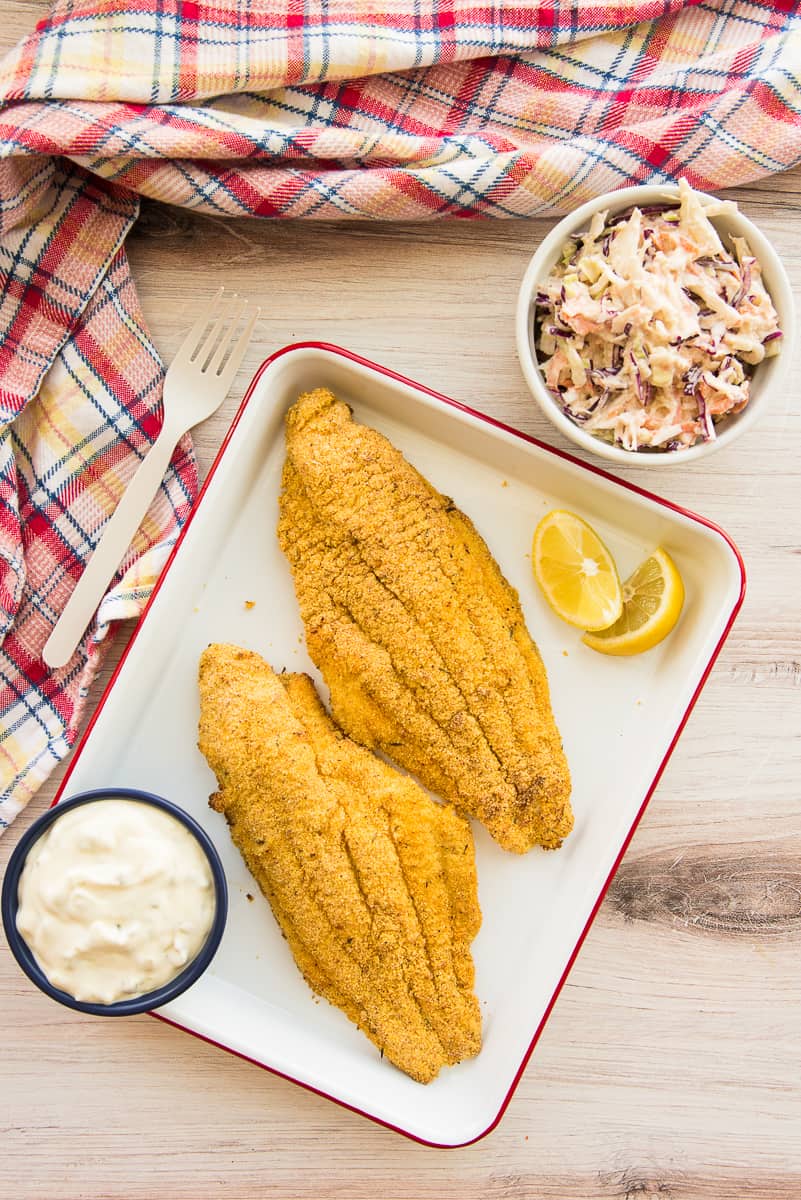
Thanks to Water Grows for sponsoring this post and giving me insight into how my catfish is raised. Read on after the recipe to see my photos from the trip.
What is Air Fried Southern Catfish?
Air fryer Southern fried catfish is less fatty than the traditional deep frying version. As a result, you can enjoy the same great flavor of the classic soul food dish without the calories.
Southern-fried catfish is breaded in a four-step breading: milk, flour, beaten eggs, then cornmeal. This version is less fussy since the catfish is only breaded in a milk and egg wash and seasoned cornmeal mixture. The result is a crispy filet with the perfect amount of seasoning.
What Do I Need to Make Air Fried Southern Catfish?
To make air fried Southern catfish, you need four catfish fillets, whole milk, seafood seasoning (Old Bay seasoning), dried thyme leaves, cayenne pepper, an egg, the juice and zest of a medium lemon, and yellow cornmeal or bread crumbs.
You can replace the catfish fillets in this recipe with similar types of fish. Choose a white fish like perch, swai, trout, or whiting.
You will also need an air fryer.
Why Do I Need to Soak the Catfish in Milk?
Farmed fresh catfish taste sweeter and has less fishy flavor than wild catfish. Since catfish are heavy, they sink, making them bottom feeders.
Soaking catfish in milk reduces that muddy flavor and fishy smell. I recommend soaking the fillets in 2 cups of whole milk for 10 minutes and discarding the milk if you use wild-caught catfish. Farmed catfish don’t need this treatment.
Whisk together the milk, egg, and juice of one lemon. This creates a buttermilk-egg wash that neutralizes any fishy taste and tenderizes the fish. This wash also allows the cornmeal to bind to the fillets. The mixture will look curdled after whisking and may thicken up. That’s just the acid from the lemon juice firming up the proteins in the egg and milk.
Can I Replace the Milk with a Lactose-Free Version?
Use lactose-free milk, like soy, coconut, or almond, for this recipe if needed.
You can also omit the lemon juice and whole milk and replace them with buttermilk.
What Kind of Cornmeal is Best for Making the Air Fried Southern Catfish?
Add the cornmeal, seafood seasoning, thyme, and cayenne to a wide, shallow dish. Use a microplane or zester to grate the reserved lemon peel into the cornmeal mixture.
Medium-ground cornmeal is the best for breading catfish. You can find this cornmeal with flour in your local grocery store. Fine cornmeal will turn to a paste, and stone-ground cornmeal will make the catfish too crunchy, if not hard. You can also replace the cornmeal in this recipe with bread crumbs.
Use your fingers to toss these ingredients together in the dish. Make sure to break up the lemon zest. The moisture in the zest causes it to clump in the mixture.
What’s the Best Air Fryer Brand for this Recipe?
The best way to prepare air fryer catfish fillets is in an air fryer with a basket tray. The air flows evenly over and under the catfish fillets when you use a tray. An air fryer basket requires you to cook only one fillet at a time, greatly increasing your cook time.
Spray the basket tray with an even coating of your favorite cooking spray to prevent sticking. I recommend canola, coconut, or olive oil spray.
Can I Make this Baked Southern Catfish instead of Air Fried?
Set up your breading station with the catfish, milk-egg bath, seasoned cornmeal, and greased tray.
Dip both sides of the catfish fillets into the milk-egg bath. Follow that by pressing both sides into the seasoned cornmeal. This ensures the cornmeal sticks to the catfish well. Lift the fillets up and shake off any excess cornmeal. Next, lay the catfish fillets on the greased tray. Continue breading the rest of the catfish fillets this way.
I can fit three generous fillets on my tray. Since I’m only making four, I split them up evenly. Wait until just before you air fry the fish to bread them. They tend to dry out and get clumpy if you bread them too far ahead. Just before air frying, spray the breaded fish lightly with more canola oil. This gives the air fryer something to bind to and gives the fillets a golden brown color.
Air fry the catfish in a 375°F (190°C) air fryer for 7 to 8 minutes or until the exterior is crisp and the fish flakes.
You can also broil these catfish fillets in a single layer on a greased sheetpan. Set the rack of your oven 8 inches from the broiler and broil them for 3 minutes. Flip the fillets and broil for another 3-4 minutes.
How Do I Serve this Air Fried Southern Catfish?
The classic way to serve air fried southern catfish is with french fries or hush puppies, homemade tartar sauce, and creamy coleslaw. Add a few lemon wedges to squeeze on the fish just before eating to add some punch. A few dashes of hot sauce never hurt nobody, either.
What Other Sides Go Well with Air Fried Southern Catfish?
Other side dishes that go well with southern catfish are:
You can also put a catfish filet between two slices of sandwich bread, slather on tartar sauce and mustard, and call it a day.
How Do I Store Leftovers?
Store leftover catfish in an airtight container in the fridge for 3-4 days.
Reheat catfish in a 350°F (180°C) air fryer for 1-2 minutes or in the oven, set to the same temp, for 8-10 minutes, or until warmed through.
Can I Freeze this Southern Catfish?
After cooking, freeze the catfish fillets until solid on a lined sheet pan. Transfer the fillets to a freezer-safe container and keep them frozen for 3 months.
Thaw before reheating the catfish or reheat from frozen as instructed above. Just add 3 to 5 minutes to account for its frozen state.
With its simple ingredients, this easy air fryer catfish recipe needs to be a frequently made dish in your home. Be sure to share the recipe with a catfish lover, and don’t forget to pin this Air Fried Southern Catfish recipe to your air fryer or seafood boards as well!
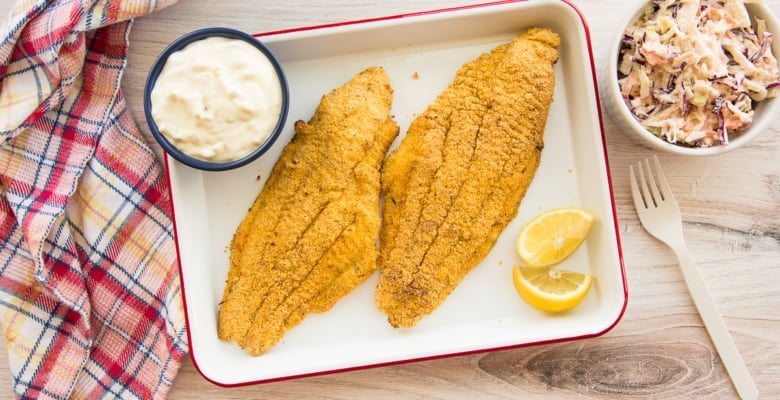
Air Fried Southern Catfish
at Sense & EdibilityEquipment
- air fryer
Ingredients
- 2 pounds (4 or 745 grams) catfish fillets rinsed and dried thoroughly
- 1/3 cup (78 milliliters) whole milk
- 1 large egg
- 1 medium lemon juiced and zested
- 1 cup (170 grams) cornmeal
- 1 tablespoon (15 grams) seafood seasoning
- 3/4 teaspoon dried thyme leaves
- 1/2 teaspoon cayenne pepper or to taste
Instructions
Prepare the Milk-Egg Bath
- In a shallow dish, whisk together the milk, egg, and juice of one lemon until it runs smooth. The mixture will look curdled after whisking and may thicken up. Set this aside.
Mix the Seasoned Cornmeal
- Add the cornmeal, seafood seasoning, thyme, and cayenne to a wide, shallow dish. Use a microplane or zester to grate the reserved lemon peel into the cornmeal mixture.
- Using your fingers, toss the ingredients together in the dish. Make sure to break up the lemon zest. Set this aside.
Bread the Catfish
- Preheat your air fryer on the "Air Fry" setting to 375°F (190°C).Spray the basket tray with an even coating of canola spray to prevent the fish from sticking to the basket.
- Set up your breading station with the catfish, milk-egg bath, seasoned cornmeal, and the greased tray. Dip both sides of the catfish fillets into the milk-egg bath. Allow the excess liquid to run off the filets back into the dish.
- Lay the fillet into the seasoned cornmeal. Press the catfish into the mixture then flip it over, pressing down again on the other side. This ensures the cornmeal sticks to the catfish well. Lift the fillets up and shake off any excess cornmeal.
- Next, lay the catfish fillets on the greased tray. Bread a second catfish fillet this way.
- Lay two fillets on the tray at a time to allow the air to circulate properly while air frying. Lightly spray the surface with more canola oil. This gives the air fryer something to bind to, which gives the fish some color. Wait until just before cooking to bread the remaining fillets.
Air Fry, then Serve
- Air fry the catfish in the preheated air fryer for 7 to 8 minutes, or until the exterior is crisp and the fish flakes.Use a thin, wide spatula to remove the catfish from the tray, and set them in a warm oven while you bread and air fry the remaining fillets.
- Serve the air fried southern catfish with french fries, homemade tartar sauce, and creamy coleslaw. Add a few wedges of lemon to squeeze on the fish and hot sauce if desired.
Notes
Swaps and Substitutions:
- For a lactose free option, use soy, coconut, or almond milk instead of whole milk.
- You can omit the lemon juice and whole milk and replace them with buttermilk.
- Replace the seafood seasoning with creole or cajun seasoning.
- Use coconut or olive oil spray instead of canola oil.
Tips and Techniques:
- If you use wild-caught catfish, soak the fillets in 2 cups of whole milk for 10 minutes, then discard the milk before proceeding with the recipe.
- You can use an air fryer with a basket but since you can cook only one filet at a time, it will greatly increase your cook time.
- Wait until just before you plan to air fry the fish to bread them or they will dry out and get clumpy.
- You can broil the catfish fillets on a greased sheetpan. Set the rack of your oven 8 inches from the broiler and broil them for 3 minutes. Flip the fillets and broil for another 3-4 minutes.
Reheating Instructions:
Reheat catfish in a 350°F (180°C) air fryer for 1-2 minutes or in the oven, set to the same temp, for 8-10 minutes, or until warmed through.Storage and Freezing Instructions:
- Store leftover catfish in an airtight container in the fridge for up to 3 days.
- To Freeze:
- After cooking, allow the catfish to cool completely.
- Freeze the catfish fillets completely on a lined sheet pan.
- Transfer the fillets to a freezer-safe container and keep them frozen for up to 3 months.
- Thaw before reheating the catfish or reheat from frozen as instructed above adding 3 to 5 minutes to account for its frozen state.
Nutrition
A Field-to-Fork Experience
Water Grows invited me to this unique Field to Fork event a couple of weeks ago. Hector and I trekked out to El Campo, Texas- midway between San Antonio and Houston- a quaint farming community, early in the morning.
The Water Grows initiative works with farmers and everyday folks like me to teach us to conserve the water we need for future generations. The Field to Fork event not only educates urban natives like me about water conservation practices but it connects food writers like me with the farmers that grow the foods I use.
Learning About Raising Catfish
I’ve never been to a catfish farm, so visiting one was exciting.
Catfish farming is a year-round operation. The catfish at the farm we visited are fed a soybean meal during daylight hours. This is when the farmers can examine each pond to ensure the fish are behaving as expected. Photosynthesis aerates the ponds during the day. A mechanical aerator takes over at night.
We were lucky enough to see the actual harvesting of the catfish on the trip.
At harvest time, a dragnet is pulled by two tractors, guiding the fish to a second net called a sock. This sock is designed to funnel and hold the fish while workers fill the basket with the live fish. While the fish are in the sock, the farmer uses a wheel to create a current in the pond. This wheel provides oxygenated water to the fish since they all breathe the same water. The sock net’s holes are gauged in a diameter that allows smaller fish to swim through, ensuring only target-size fish are harvested. I can’t tell you how awe-inspiring it was to see these men wrestling to lift the sock up and over to dump the catfish into the basket. Yet another reason farmers and their workers deserve more respect and pay.
A crane hoists the basket of fish into a waiting tank truck. After filling the tank trailer, the fish are transported to a processing facility.
I’m really glad I can share this experience with you since it was so inspiring for me.

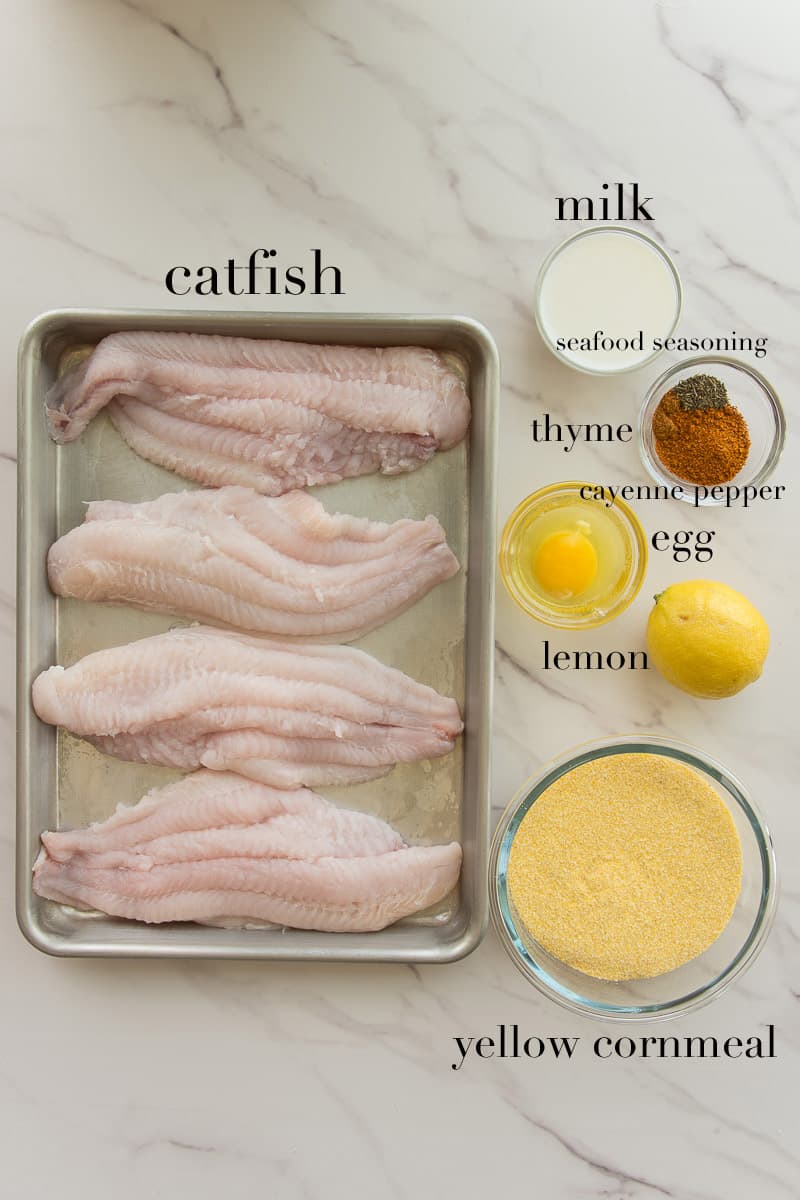
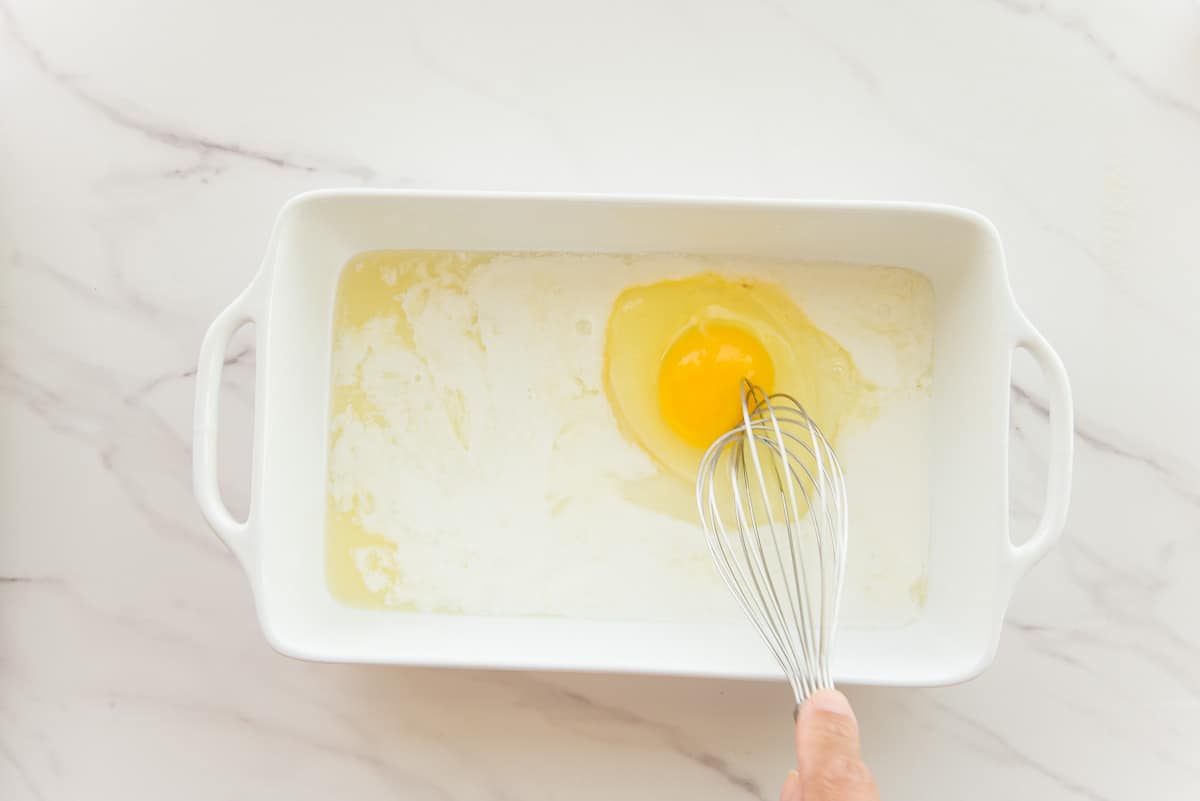
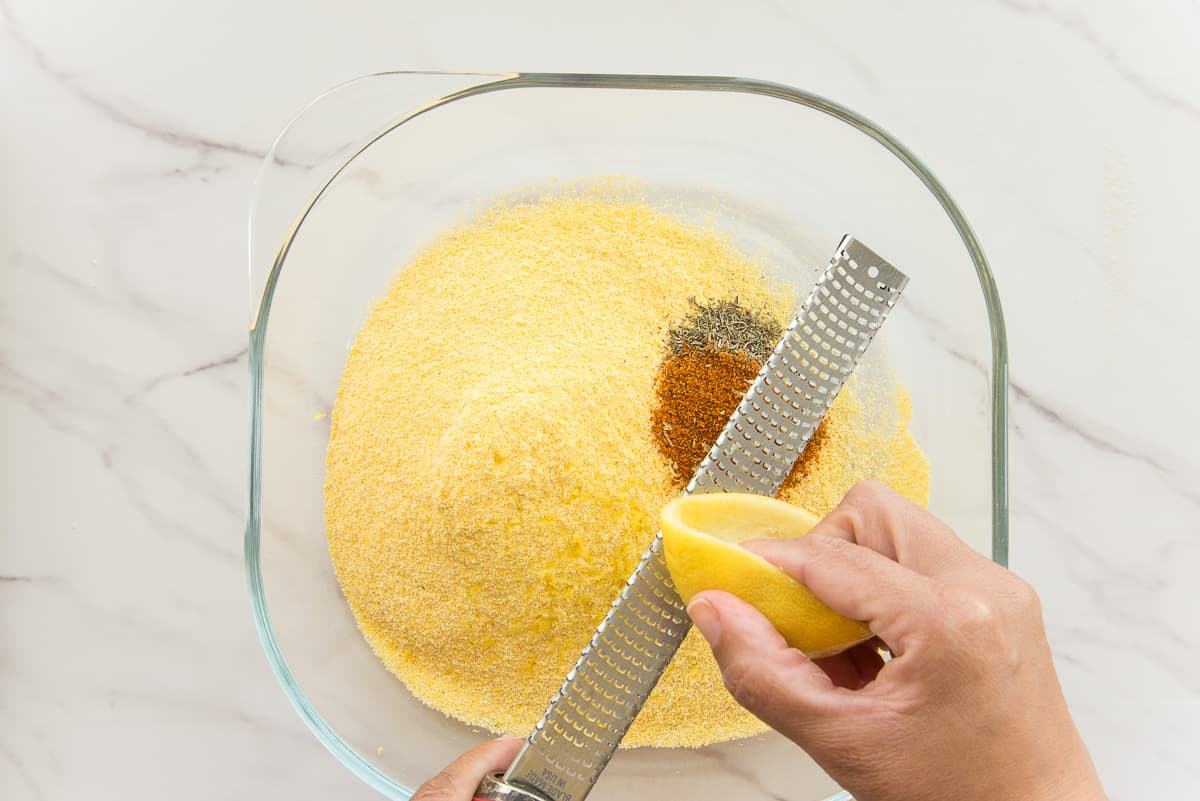
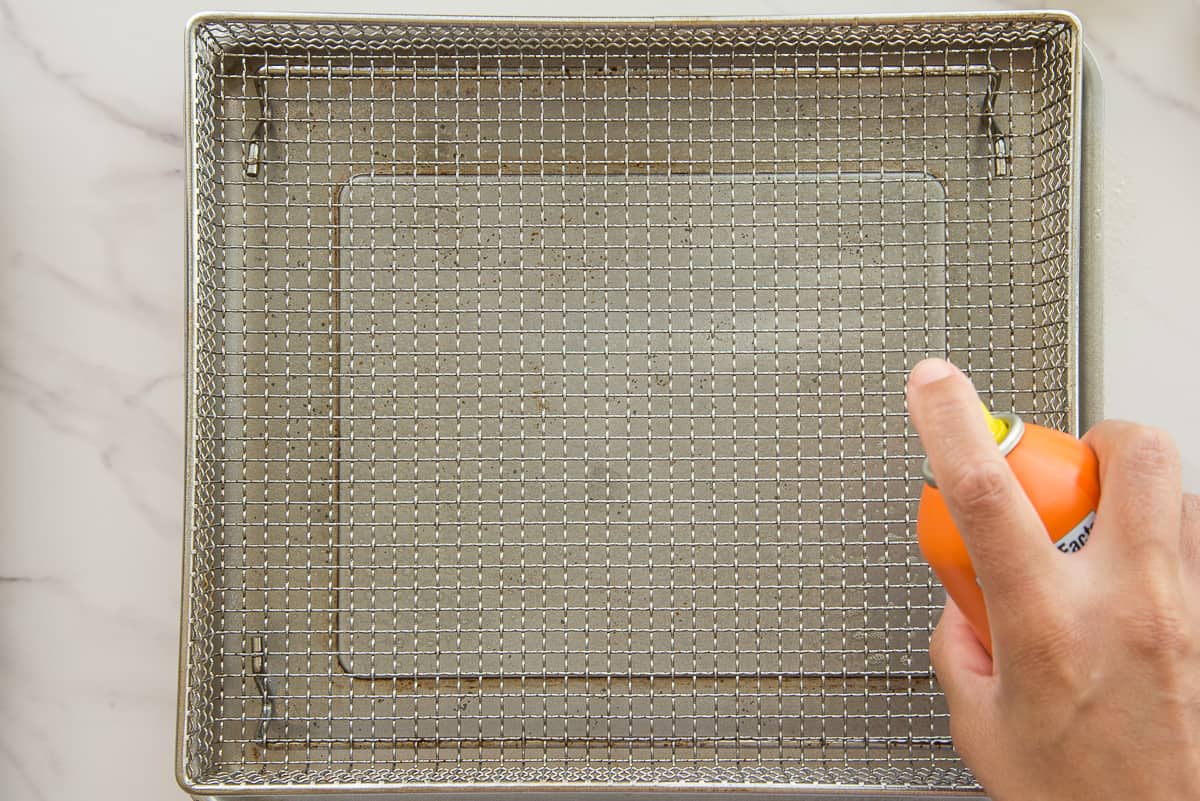
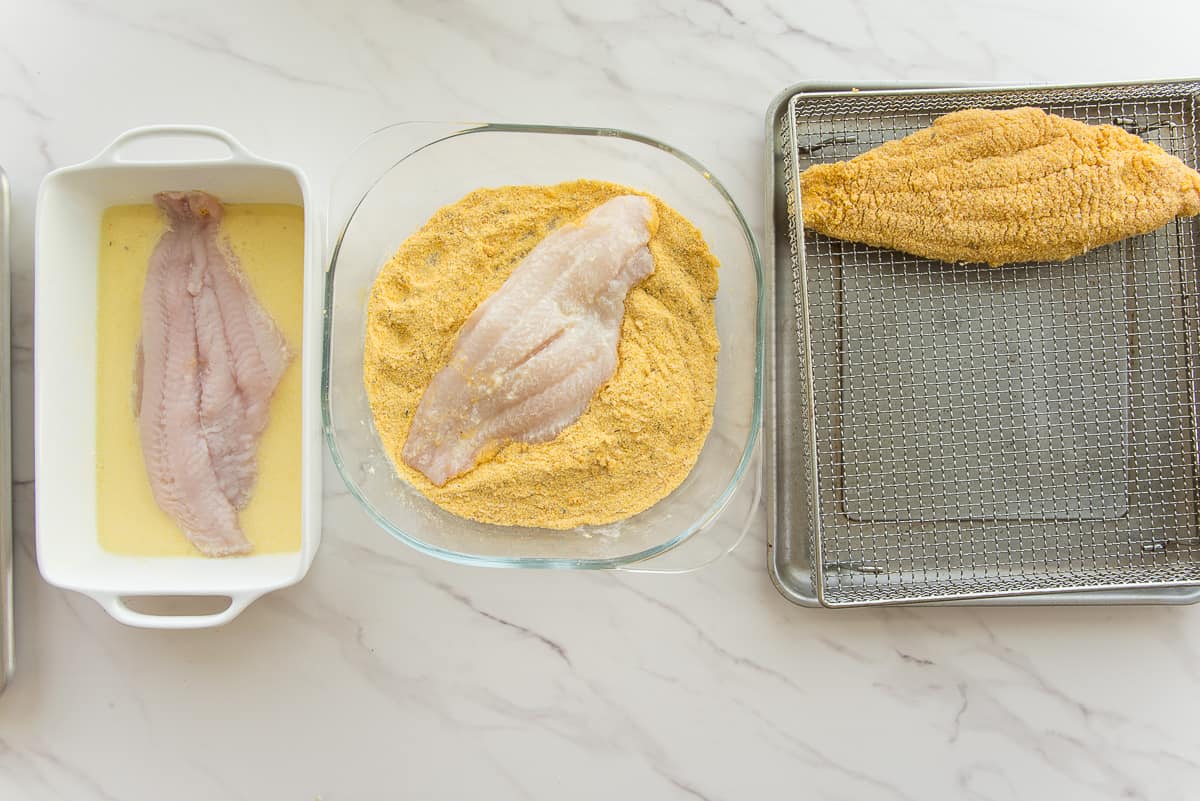
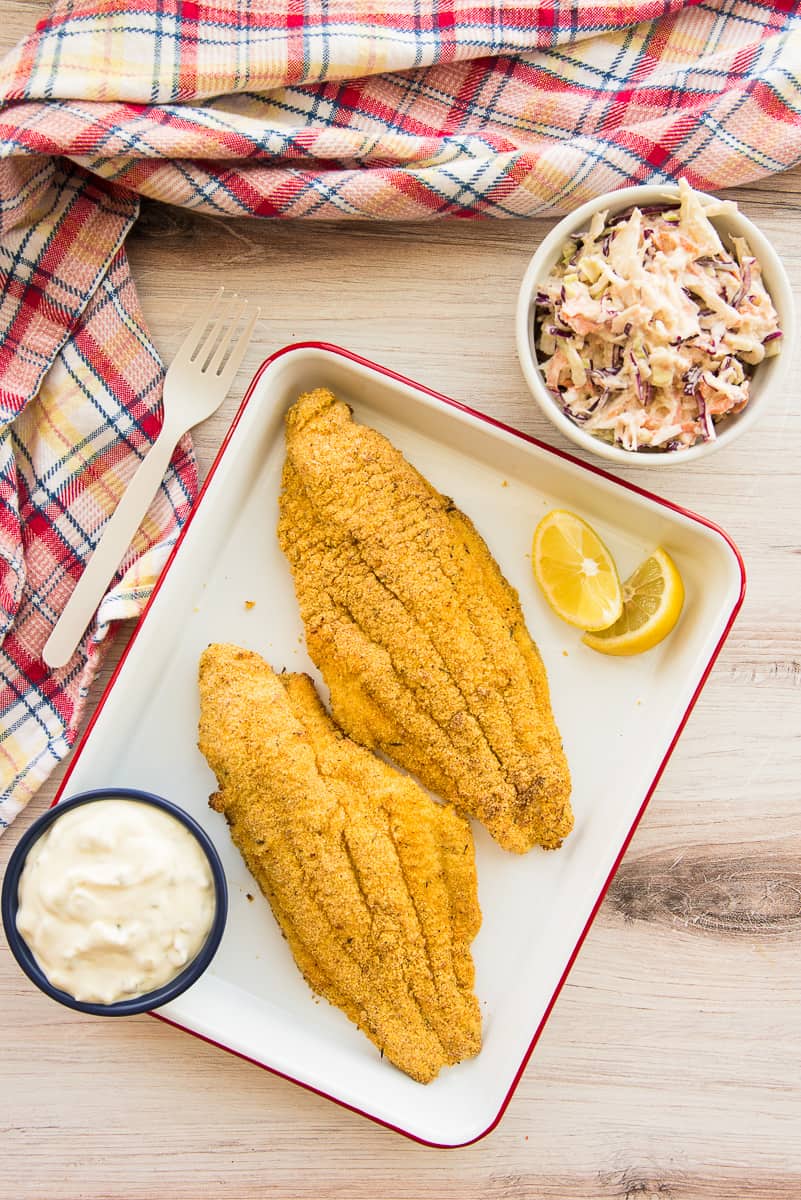
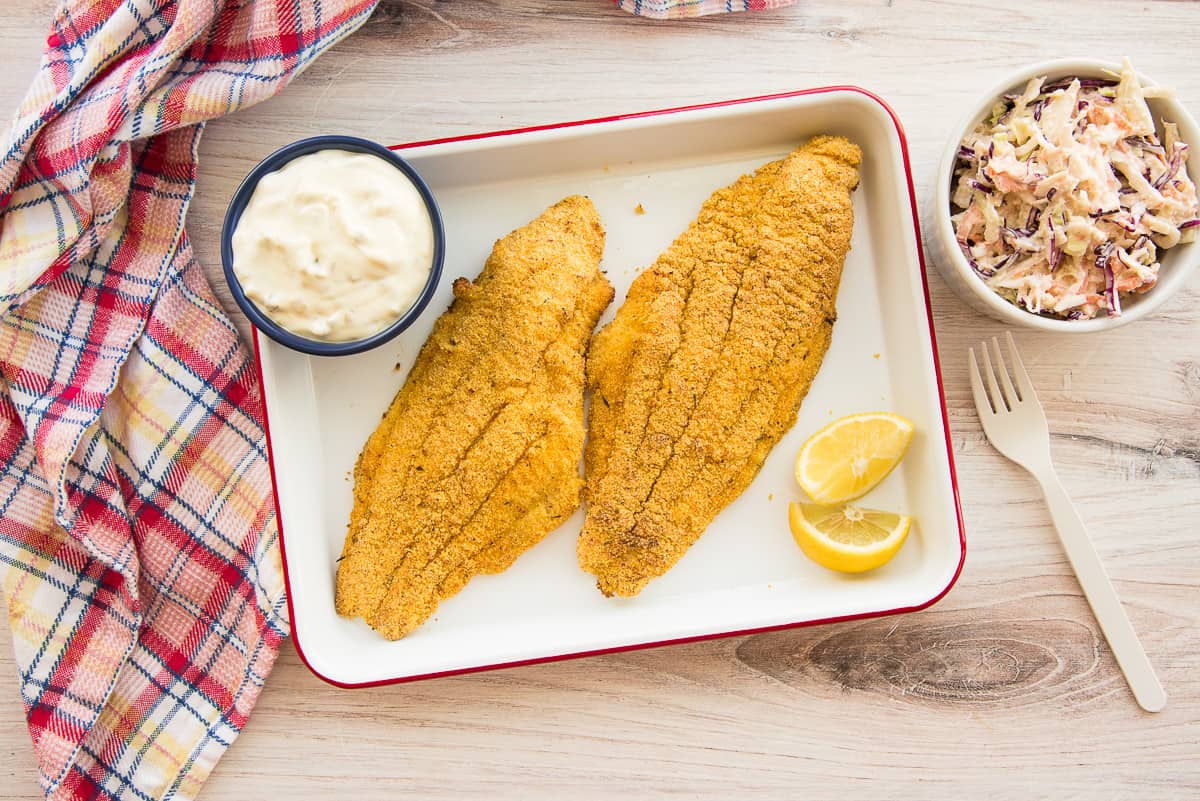
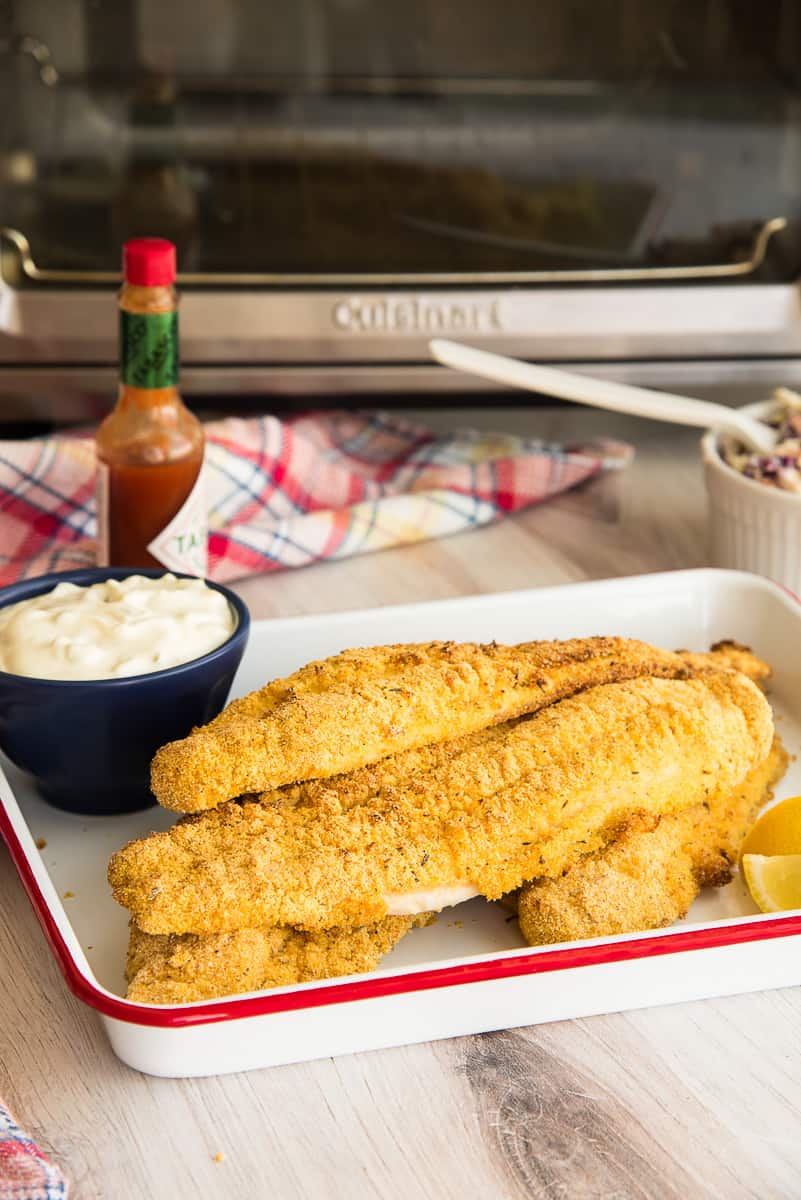


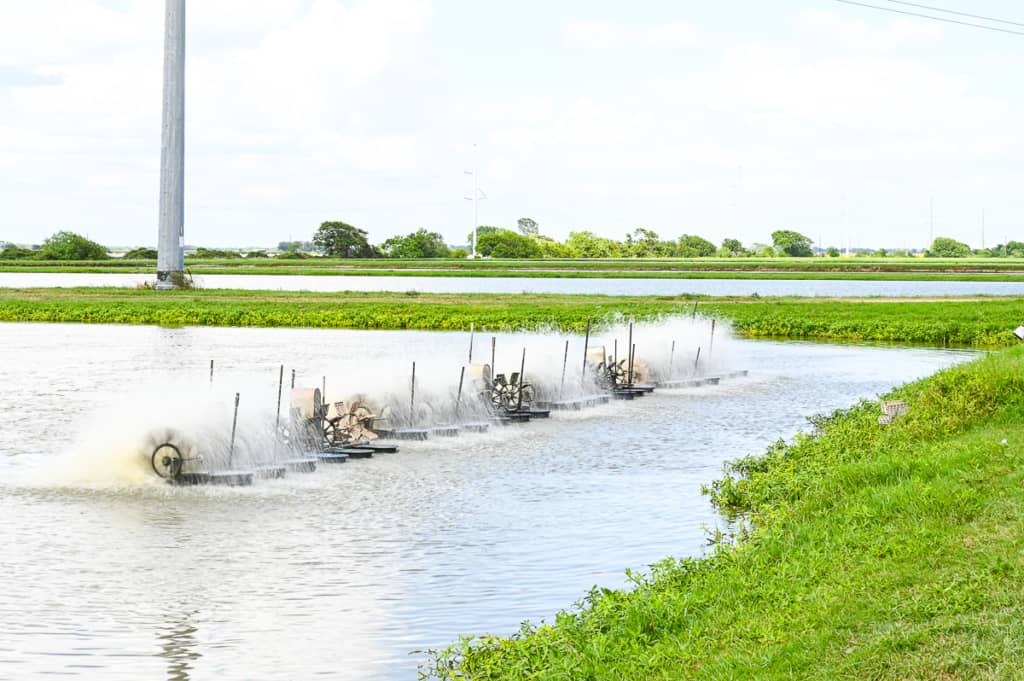
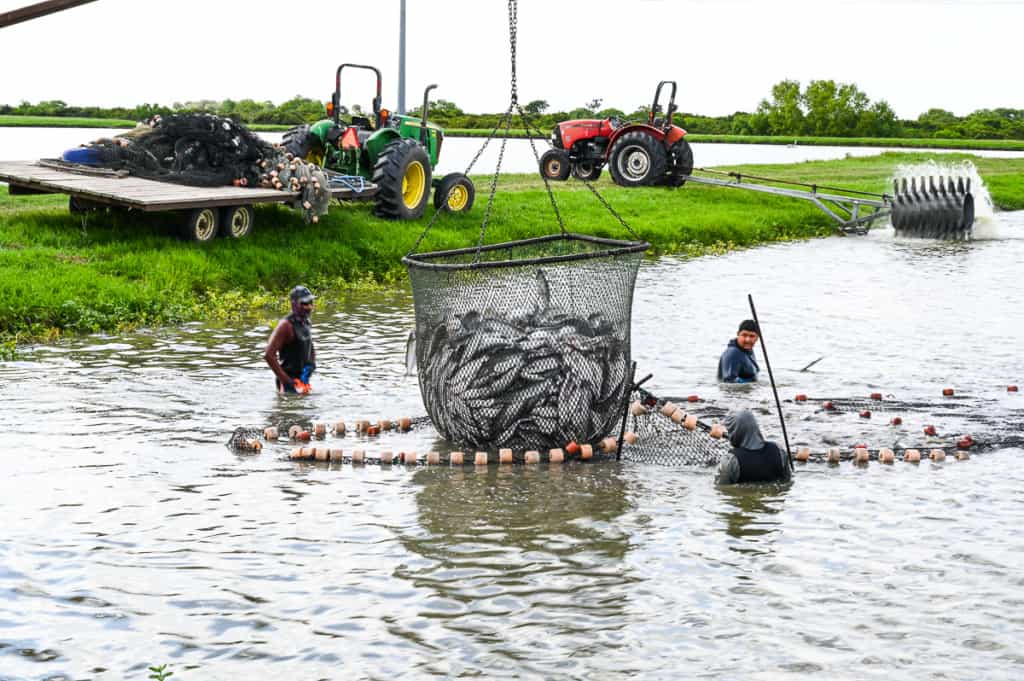
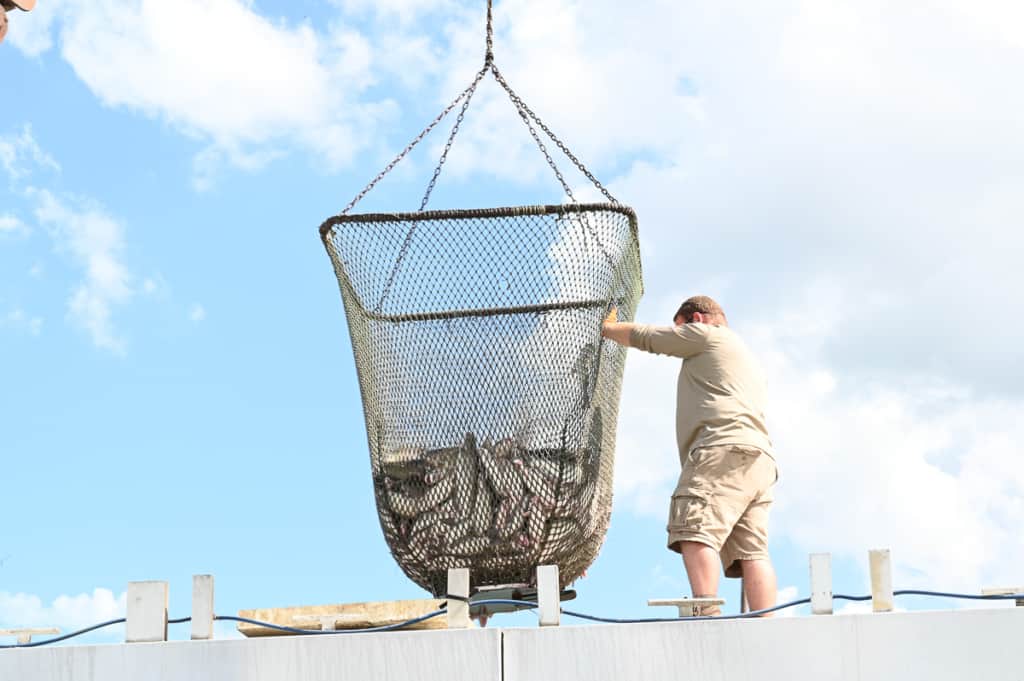





Do you have a recipe for hush puppies? I’m not sure I can eat fried catfish without them!
I don’t have one on the site yet, but I’ll work on it!
You’re the best – thank you! The catfish recipe looks amazing – can’t wait to make it!
Looks sooo good! I need to try this recipe!! Thanks for sharing an air fryer version!!
You’re welcome, Julie!
Followed every step and got perfectly crispy catfish and the taste was on point. Thank you! And you are so right about farmed catfish flavor!
Thank you, Jazz!